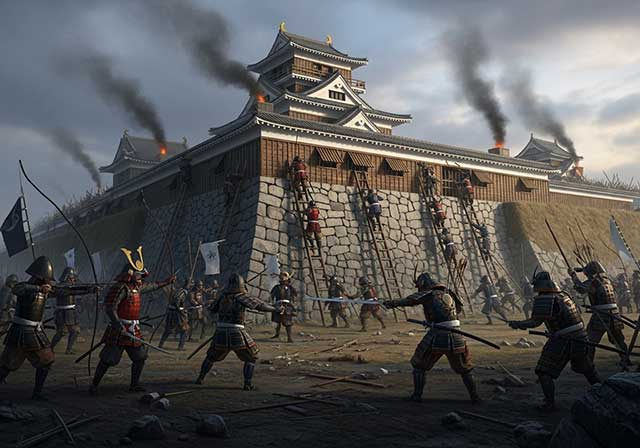
The Oda clan came to power in the province of Owari in the 15th century as a result of the so-called gokoku-jo, or “overthrow of the higher by the lower.” By rebelling against their suzerain, the Shiba clan, the Oda were able to achieve independence. However, this victory led to internal strife: the clan split into two rival branches.
One branch, known as Ise-no-Kami, fortified itself in Iwakura Castle. The other branch, Yamato-no-Kami, occupied Kiyosu Castle.
In the middle of the 16th century, a young and energetic commander named Oda Nobunaga rose to prominence in the clan. Making Kiyosu Castle his main base, he began to purposefully unite the entire province of Owari under his rule.
First, Nobunaga brutally dealt with his closest relatives, who were eliminated as dangerous rivals. Then he turned his attention to the neighboring branch of the clan, which held Iwakura Castle. At that time, the castle was commanded by Oda Nobuyasu and Oda Nobukata.
Iwakura Castle was a powerful fortification. It was surrounded by a double moat, stretching approximately 90 meters from west to east and about 170 meters from north to south. The fortress was complemented by watchtowers and other defensive structures.
In June 1559, Nobunaga launched an attack on the castle. First, he ordered the burning of the castle town to clear the approaches to the fortress. After that, the castle was completely surrounded by numerous barricades and was besieged.
The siege lasted more than two months. Nobunaga systematically wore down the defenders, using incendiary arrows, gunfire, and sudden assault attacks.
In the end, the defenders of the castle decided that further resistance was pointless. They opened the gates and surrendered. The garrison was allowed to leave the besieged territory unhindered. After the castle surrendered, Nobunaga ordered the destruction of the Iwakura fortifications and returned to Kiyosu.
During the siege, Yamauchi Moritoyo, the father of Yamauchi Kazutoyo, Nobunaga's future vassal and hero of the battles of Anegawa and Nagashino, was killed. Moritoyo fought on the side of the defeated. The fall of Iwakura Castle marked the final point in the unification of the province of Owari under the rule of Oda Nobunaga.
See also
-
The Siege of Hara Castle

The Shimabara Rebellion of 1637–1638, which culminated in the siege of Hara Castle, was the last major uprising of the Edo period and had serious political consequences.
-
Battle of Tennoji

The confrontation between Tokugawa Ieyasu and Toyotomi Hideyori during the “Osaka Winter Campaign” ended with the signing of a peace treaty. On January 22, 1615, the day after the treaty was signed, Ieyasu pretended to disband his army. In reality, this meant that the Shimazu forces withdrew to the nearest port. On the same day, almost the entire Tokugawa army began filling in the outer moat.
-
Siege of Shuri Castle

The Ryukyu Kingdom was established in 1429 on Okinawa, the largest island of the Ryukyu (Nansei) archipelago, as a result of the military unification of three rival kingdoms. In the following years, the state's control spread to all the islands of the archipelago.
-
The Siege of Fushimi Castle

Fushimi can perhaps be considered one of the most “unfortunate” castles of the Sengoku Jidai period. The original castle was built by Toyotomi Hideyoshi in the southeast of Kyoto in 1594 as his residence in the imperial city.
-
The Siege of Otsu Castle

The siege of Otsu Castle was part of the Sekigahara campaign, during which the so-called Eastern Coalition, led by Tokugawa Ieyasu, fought against the Western Coalition, led by Ishida Mitsunari. Otsu Castle was built in 1586 by order of Toyotomi Hideyoshi near the capital Kyoto, on the site of the dismantled Sakamoto Castle. It belonged to the type of “water castles” — mizujō — as one side of it faced Japan's largest lake, Lake Biwa, and it was surrounded by a system of moats filled with lake water, which made the fortress resemble an island.
-
The Siege of Shiroishi Castle

The siege of Shiroishi Castle was part of the Sekigahara campaign and took place several months before the decisive battle of Sekigahara. The daimyo of Aizu Province, Uesugi Kagekatsu, posed a serious threat to Tokugawa Ieyasu's plans to defeat the Western Coalition, and Ieyasu decided to curb his actions with the help of his northern vassals. To this end, he ordered Date Masamune to invade the province of Aizu and capture Shiroishi Castle.
-
The Second Siege of Jinju Castle

During the two Korean campaigns of the 16th century, the Japanese repeatedly had to capture enemy fortresses and defend occupied or constructed fortifications from the combined Korean and Chinese forces. Among all the operations of that time, the second siege of Jinju Castle is considered the most interesting from the point of view of siege warfare.
-
The Siege of Takamatsu Castle

The siege of Takamatsu Castle in Bitchu Province is considered the first mizuzeme, or “water siege,” in Japanese history. Until then, such an original tactic had never been used.

